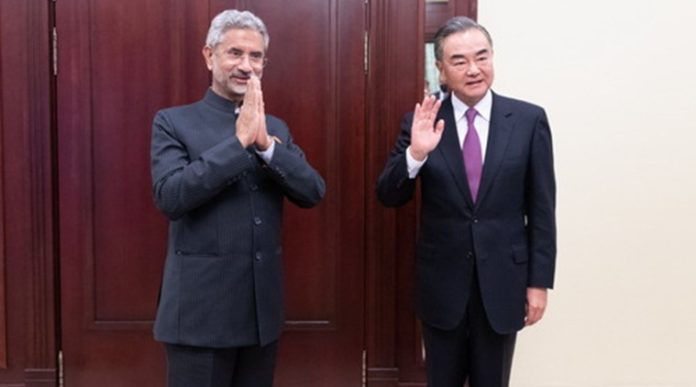COLUMN
The five-point Agreement stamped during a meeting between External Affairs Minister S Jaishankar and his Chinese counterpart Wang Yi in Moscow has created a lot of hype and hope.
While it’s not a bad idea to pin hopes, the Moscow pact needs to be recognized with a sense of scepticism, considering that China has brazenly shown total disregard to all the agreements and understandings reached with India over the last 27 years.
Therefore, the fresh agreement on the issue of peace and tranquillity on the Line of Actual Control (LAC) against the backdrop of heightened aggression by China at the LAC in Ladakh sector needs to be taken with a pinch of salt.
Although all eyes were on the meeting and its outcome in view of the volatile situation at the Ladakh border, the Agreement can be called anything but a breakthrough to end the dangerous faceoff between two biggest powers of Asia since the most crucial part is its implementation by China.
India will need to implement the agreement with a sense of distrust in China. Verification of the Chinese actions on the ground is most critical.
A Joint Statement issued after the meeting on September 10 said both sides “agreed that the current situation in the border areas is not in the interest of either side” and “therefore the border troops of both sides should continue their dialogue, quickly disengage, maintain proper distance and ease tensions.”
Significantly, the Agreement has no mention about restoring status quo ante at the Ladakh border, where Chinese Peoples Liberation Army has tried to alter the LAC.
Hence, a crucial question arises whether the Chinese Peoples Liberation Army will vacate the areas where it has made advances.
The Joint Statement said the two Ministers agreed that both sides should take guidance from the series of consensus of the leaders on developing India-China relations, including not allowing differences to become disputes.
They also agreed that both sides shall abide by all the existing agreements and protocol on China-India boundary affairs, maintain peace and tranquillity in the border areas and avoid any action that could escalate matters.
The two sides also agreed to continue to have dialogue and communication through the Special Representative mechanism on the India-China boundary question. They also agreed in this context that the Working Mechanism for Consultation and Coordination on India-China border affairs (WMCC), should also continue its meetings, the Joint Statement said.
Most of these elements are repetitively old and have already been violated by China in Galwan valley and Pangong Lake area.
In Galwan valley, a physical fight between the armies of the two countries in June resulted in the death of 20 Indian soldiers and unspecified number on the Chinese side. In Pangong Lake area, shots were fired by the PLA, marking first such instance in 45 years.
Chinese Foreign Minister Wang seemed to give a hint that his country’s troops may not be in a mood to restore the status quo ante in the Ladakh sector when he said, “The most important thing is to avoid new violations of the obligations on the border.”
His reference to “new violations”, in comments made a day after his meeting with Jaishankar, could mean that the violations that already took place from the Chinese side won’t be corrected.
The Joint Statement said the Ministers agreed that as the situation eases, the two sides should expedite work to conclude new Confidence-Building Measures to maintain and enhance peace and tranquillity in the border areas.
Far from the Confidence-Building Measures, the India-China relations have been hit by a huge distrust because of the PLA’s misadventure.
Significantly, the deceitful act by China came in a year which marks 70th anniversary of establishment of diplomatic relations. The two countries had planned 70 programmes throughout the year to mark the anniversary.
The aggression by China, which began in May, means that Beijing has not only betrayed India but also disregarded pacts like the 1993 Agreement on Maintenance of Peace and Tranquility in border areas and the Political Parameters and Guiding Principles Agreement signed in May 2005 during the India visit of then Chinese Prime Minister Wen Jiabao, under which the two sides vowed to settle pending disputes through talks.
China, authoritatively ruled by the Communist Party, has once again proved to an unreliable country.
Over the last two decades or so, it has been saying that India and China are “partners” and not “rivals” or “competitors” but four months back, it did exactly the opposite by launching aggression at the LAC.
It has also been claiming that it wants to resolve the border dispute through talks but carried out military action to change the LAC.
Significantly, Prime Minister Narendra Modi had in 2015 proposed that there should be a proper clarification regarding the LAC to better understand the positions of the two neighbours.
China did not accept this proposal, saying it prefers a pact with India on a Code of Conduct to maintain peace along the border.
“Whatever we do in the border area it should be constructive. That means it should be a building block for the process of negotiations not stumbling block,” Deputy Director General of the Asian Affairs at the Chinese Foreign Ministry Huang Xilian had said in June 2015, just days after Modi’s visit to China.
“If we find that clarification of the LAC is building block then we should go ahead. But if we find that it is a
stumbling block it could complicate the situation further. We have to be careful,” said Huang, the Ministry’s point man for India.
“Our position is that we have to seek some kind of comprehensive measures, not only one measure to control and manage the border to ensure peace and tranquillity along the border. We can try and reach an agreement on the Code of Conduct,” Huang had said.
Earlier too, a question — whether China is India’s enemy or friend – has been propping up because of provocative actions by China from time to time, be it Arunachal Pradesh, Kashmir or its over enthusiastic cooperation with Pakistan in certain areas that hurt India’s interests and sentiments.
China has been laying territorial claims over Arunachal Pradesh and its military has been demonstrating its aggressiveness there, with its troops transgressing into Indian territory and staying there for some time before returning.
Along with these actions, China had been building its military assets and infrastructure close to the border at a rapid pace, raising suspicions in India about its intentions.
For years, India watched the Chinese build-up but did nothing. However, over a decade back, India initiated steps to match the infrastructure development of China.
Projects have been undertaken to build roads and other infrastructure in the mountainous Himalayan region with an aim of facilitating easier movement of troops and equipment to the China border.
China has also irritated India by issuing visas to Kashmiris on loose sheets of paper instead of their Indian passports. This was done to indicate that it does not consider Kashmir a part of India but a separate entity, a claim similar to that of Pakistan.
This action caused a lot of unease in the Indian establishment in 2010, which registered its protest with China a number of times.
Besides, China has been undertaking a number of developmental projects like building of power plants in Pakistan-occupied Kashmir (PoK) despite India’s publicly-stated reservations.
India maintains that PoK is a part of India and Pakistan has no legal right to build any project there, least China.
Despite all these problems, India always held that it is important to “manage difficulties” to realise the postives in the relationship. The Indian government would point to the huge potential in trade and economic field, which had been increasing at rapid pace over the last two decades.
From a trade volume of a few billion dollars in the year 2000, China became India’s largest trading partner in about a decade. The bilateral trade in 2008 reached USD 51.8 billion.
Similarly, the two countries were cooperating closely on major international issues like climate change.
The Summit on Climate Change held in Copenhagen in December 2009 saw the closest cooperation between India and China, which was instrumental in blocking the move of developed countries to impose an agreement that was not in favour of developing and least developed nations.
By understanding aggression on Ladakh border, China has ensured that the entire bilateral relationship with India is redefined.
There will no more be business as usual.








